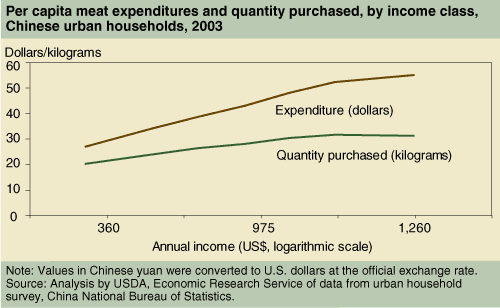Chinese Consumers Demand Premium Foods
- by Fred Gale and Kuo Huang
- 6/1/2007
Food expenditures in China are changing as households experience income growth. At higher income levels, consumers tend to diversify their food purchases to include more poultry, fish, dairy, fruit, and beverages, while purchases of rice, flour, and pork remain about the same. This trend took hold soon after China’s economy began expanding rapidly during the 1980s. A more recent trend is the increasing propensity of Chinese consumers to purchase higher quality as well as greater quantities of food.
Modern food markets have given Chinese consumers an expanded array of food choices—different cuts of meat, tropical fruit, organic vegetables, milk with special additives, instant noodles—and consumers are spending more for each unit of food purchased. Analysis of Chinese household surveys shows that, as household income rises, per capita expenditures on meat grow faster than per capita quantity purchased. This trend happens if consumers buy premium-priced items: better cuts of meat; branded, packaged, or processed items; or meats that attain rigorous safety certifications. Similarly, high-income households in China tend to buy smaller volumes of rice, flour, and other grain products than do low-income households, but spend more on premium-priced items like imported jasmine rice, branded domestic rice, processed rice and wheat products, and western-style breads.
The demand for “quality” is an important component of food expenditure growth for nearly all food categories studied using data from the Chinese household survey for 2002-03. That demand has driven China’s rapid growth in supermarkets, convenience stores, and restaurants—outlets that offer greater convenience and quality in food purchases. The emerging Chinese demand for premium foods has been a boon for U.S. farm products. For example, U.S. apples and oranges have established a significant high-end niche in China. U.S. exports of fruit and fruit products to China grew to $106.5 million in 2006, more than triple the value in 2002, despite selling at prices three to four times higher than those of domestic fruit. The increase in discretionary food spending also has triggered many investments by U.S. food manufacturers, retailers, and foodservice chains in China.
This article is drawn from:
- Gale, F. & Huang, K. (2007). Demand for Food Quantity and Quality in China. U.S. Department of Agriculture, Economic Research Service. ERR-32.
You may also like:
- China. (n.d.). U.S. Department of Agriculture, Economic Research Service.


